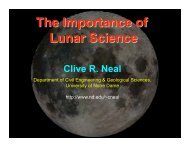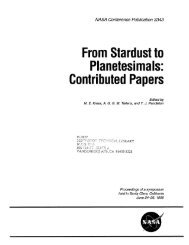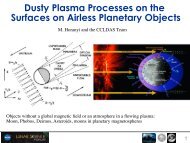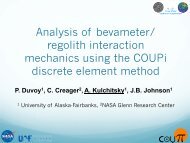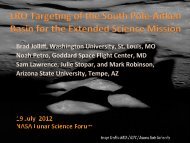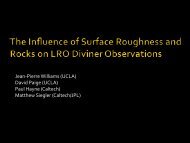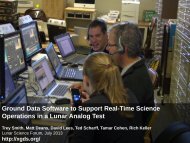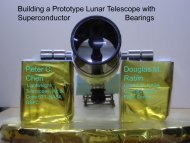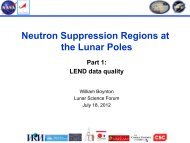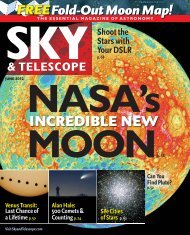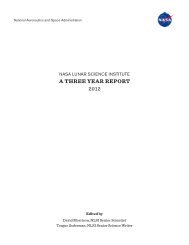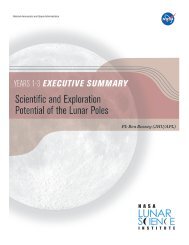Time-Resolved Temperature Measurements in Hypervelocity Dust ...
Time-Resolved Temperature Measurements in Hypervelocity Dust ...
Time-Resolved Temperature Measurements in Hypervelocity Dust ...
Create successful ePaper yourself
Turn your PDF publications into a flip-book with our unique Google optimized e-Paper software.
<strong>Time</strong>-<strong>Resolved</strong> <strong>Temperature</strong> <strong>Measurements</strong> <strong>in</strong><br />
<strong>Hypervelocity</strong> <strong>Dust</strong> Gra<strong>in</strong> Impact<br />
A. Collette 1 , K. Drake 1 , A. Mocker 1,2 ,<br />
Z. Sternovsky 1 , M. Horanyi 1<br />
1<br />
Colorado Center for Lunar <strong>Dust</strong> And Atmospheric Studies, Boulder, CO<br />
2<br />
IRS, Universität Stuttgart, Germany
CCLDAS studies on impact physics<br />
COLORADO CENTER<br />
FOR LUNAR DUST AND<br />
ATMOSPHERIC STUDIES<br />
The Colorado Center for Lunar <strong>Dust</strong> and Atmospheric Studies (CCLDAS) is an NLSI team<br />
focused on understand<strong>in</strong>g properties of the Moon and other airless bodies through a<br />
comb<strong>in</strong>ation of experiment, theory and simulation.<br />
The flagship experimental device at CCLDAS is an electrostatic dust accelerator which<br />
can be used for basic science <strong>in</strong>vestigation or for <strong>in</strong>strument calibration (e.g. LDEX).<br />
We are <strong>in</strong> the midst of a measurement campaign aimed at <strong>in</strong>vestigat<strong>in</strong>g follow<strong>in</strong>g<br />
aspects of hypervelocity impact:<br />
Impact-produced ionization<br />
Crater<strong>in</strong>g<br />
Impact-generated neutral gas<br />
Ejecta generation<br />
<strong>Temperature</strong> measurement (via light flash)<br />
Lunar Science Forum 2012 7/16/2012<br />
2
Summary<br />
COLORADO CENTER<br />
FOR LUNAR DUST AND<br />
ATMOSPHERIC STUDIES<br />
We are us<strong>in</strong>g the impact-generated light flash from dust gra<strong>in</strong>s mov<strong>in</strong>g at<br />
speeds from 1-40 km/sec impact<strong>in</strong>g a metallic target<br />
Measures conditions on microsecond time scales follow<strong>in</strong>g impact<br />
Us<strong>in</strong>g a three-color technique under the assumption of blackbody radiation<br />
We get the blackbody temperature and radiant power as a function of time<br />
Also temperature variation with velocity<br />
Summary of f<strong>in</strong>d<strong>in</strong>gs:<br />
<strong>Time</strong>-averaged temperatures 2500K-5000K, <strong>in</strong>creas<strong>in</strong>g with velocity<br />
Initial (1μs) temperatures up to twice the time-averaged temperature<br />
Radiant power does not drop off quickly, but stays elevated for 10’s of μs<br />
Lunar Science Forum 2012 7/16/2012<br />
3
Light energy is a strong function of v<br />
COLORADO CENTER<br />
FOR LUNAR DUST AND<br />
ATMOSPHERIC STUDIES<br />
May experiments undertaken <strong>in</strong> the 1960s and 1970s <strong>in</strong>to the physics of dust<br />
impact, as part of the Apollo-era concern about the effect on spacecraft and<br />
astronauts.<br />
For metal/metal impacts:<br />
At most ~0.01% k<strong>in</strong>etic energy<br />
goes <strong>in</strong>to light energy, depend<strong>in</strong>g<br />
on the target material<br />
Blackbody temperatures <strong>in</strong> the<br />
3000-5000K range<br />
Light energy scales l<strong>in</strong>early with<br />
mass, and strongly with velocity<br />
(v 3 – v 4 )<br />
G. Eichhorn (1975)<br />
Lunar Science Forum 2012 7/16/2012<br />
4
Light source treated as a blackbody<br />
COLORADO CENTER<br />
FOR LUNAR DUST AND<br />
ATMOSPHERIC STUDIES<br />
Strictly speak<strong>in</strong>g, it’s not; l<strong>in</strong>e emission<br />
has been measured for large projectiles<br />
<strong>in</strong> light gas gun experiments<br />
Very difficult to perform spectroscopy on<br />
dust impacts, because of the limited light<br />
available<br />
Unclear on what timescales l<strong>in</strong>e emission<br />
is dom<strong>in</strong>ant for dust impacts<br />
<strong>Measurements</strong> by Eichhorn and (earlier)<br />
Friichtenict <strong>in</strong>dicate blackbody radiation<br />
is a reasonable approximation<br />
Full spectra of the flash is planned to be<br />
measured <strong>in</strong> future experiments at<br />
CCLDAS<br />
G. Eichhorn (1976)<br />
Lunar Science Forum 2012 7/16/2012<br />
5
CCLDAS <strong>Dust</strong> Accelerator<br />
COLORADO CENTER<br />
FOR LUNAR DUST AND<br />
ATMOSPHERIC STUDIES<br />
Launches charged micron-sized<br />
and smaller conduct<strong>in</strong>g dust<br />
gra<strong>in</strong>s<br />
Design range 1-100 km/sec<br />
(1-40 km/sec <strong>in</strong> this talk)<br />
In-l<strong>in</strong>e detectors measure<br />
particle velocity and charge<br />
(also giv<strong>in</strong>g mass) on particleby-particle<br />
basis<br />
Lunar Science Forum 2012 7/16/2012<br />
6
Experimental Setup<br />
COLORADO CENTER<br />
FOR LUNAR DUST AND<br />
ATMOSPHERIC STUDIES<br />
Incom<strong>in</strong>g dust gra<strong>in</strong>s strike a tungsten target, produc<strong>in</strong>g a light flash<br />
Up to four photomultiplier modules can observe the flash<br />
simultaneously (3 <strong>in</strong> this experiment)<br />
Each photomultiplier has a 40nm FWHM bandpass filter; center<br />
wavelengths are at 400, 450, 670 nm.<br />
Phototubes use 1us <strong>in</strong>tegration time<br />
<strong>Dust</strong> beam<br />
Lunar Science Forum 2012 7/16/2012<br />
7
PMT Output (3 filters)<br />
COLORADO CENTER<br />
FOR LUNAR DUST AND<br />
ATMOSPHERIC STUDIES<br />
Lunar Science Forum 2012 7/16/2012<br />
8
Comput<strong>in</strong>g temperature<br />
COLORADO CENTER<br />
FOR LUNAR DUST AND<br />
ATMOSPHERIC STUDIES<br />
<strong>Temperature</strong> computer per-particle, and as a function of time.<br />
<br />
<br />
<br />
<br />
<br />
<br />
<br />
3 photocurrent time traces acquired from 400, 450 and 670 nm modules<br />
Each module calibrated to a NIST-calibrated photodiode, provid<strong>in</strong>g<br />
photocurrent as a function of spectral irradiance (W/m^2/nm), at several<br />
wavelengths across the width of the filter<br />
Source is modeled as a blackbody with temperature T and radiat<strong>in</strong>g<br />
area A, emitt<strong>in</strong>g isotropically <strong>in</strong>to 2pi<br />
A time w<strong>in</strong>dow of <strong>in</strong>terest is selected, and the mean of each photocurrent is<br />
computed <strong>in</strong> that w<strong>in</strong>dow (produc<strong>in</strong>g three photocurrent values)<br />
The filter calibration is used to compute the photocurrent generated by each<br />
module for at a given (A,T) comb<strong>in</strong>ation<br />
A two-parameter least-squares fit is used to f<strong>in</strong>d the (A,T) pair which best<br />
reproduces the observed photocurrents<br />
We compute a goodness-of-fit characteristic (R^2) which can be used to<br />
identify cases <strong>in</strong> which the fit is unreliable<br />
Lunar Science Forum 2012 7/16/2012<br />
9
<strong>Time</strong>-average T <strong>in</strong>creases with v<br />
COLORADO CENTER<br />
FOR LUNAR DUST AND<br />
ATMOSPHERIC STUDIES<br />
An ensemble of data was collected for particles with speeds rang<strong>in</strong>g from 1-40<br />
km/sec<br />
“Average temperature”:<br />
take the mean<br />
photocurrent values over a<br />
20μs w<strong>in</strong>dow<br />
Goodness-of-fit R 2 > 0.90<br />
required for the fit to pass<br />
<strong>Temperature</strong> of highestspeed<br />
impact only 5400K<br />
More high-speed particles<br />
are needed to assess<br />
functional dependence<br />
Lunar Science Forum 2012 7/16/2012<br />
10
<strong>Time</strong>-<strong>Resolved</strong> Photocurrent<br />
COLORADO CENTER<br />
FOR LUNAR DUST AND<br />
ATMOSPHERIC STUDIES<br />
Photocurrent time series is divided<br />
<strong>in</strong>to 0.5us time <strong>in</strong>tervals<br />
At each time <strong>in</strong>terval, the area and<br />
temperature of the radiator is<br />
computed subject to R^2 test<br />
Fit succeeds for about the first<br />
20us of the flash, when the signal<br />
enters the noise level<br />
Lunar Science Forum 2012 7/16/2012<br />
11
<strong>Time</strong>-<strong>Resolved</strong> <strong>Temperature</strong>/Area<br />
COLORADO CENTER<br />
FOR LUNAR DUST AND<br />
ATMOSPHERIC STUDIES<br />
Dashed l<strong>in</strong>e shows timeaveraged<br />
(20us) temperature<br />
used <strong>in</strong> velocity plot<br />
At early times, temperature<br />
is substantially enhanced<br />
After <strong>in</strong>itial fast decay,<br />
temperature slowly drops<br />
from about 3700K to 3200K<br />
Radiat<strong>in</strong>g area starts small<br />
but then surpris<strong>in</strong>gly<br />
constant over the life of the<br />
flash<br />
<strong>Temperature</strong><br />
Dashed l<strong>in</strong>e is average from<br />
20us technique<br />
Effective radiat<strong>in</strong>g area<br />
Lunar Science Forum 2012 7/16/2012<br />
12
Radiant Power<br />
COLORADO CENTER<br />
FOR LUNAR DUST AND<br />
ATMOSPHERIC STUDIES<br />
We can compute the total power<br />
as a function of time from the<br />
Stefan-Boltzmann law<br />
It had been <strong>in</strong>ferred from<br />
photocurrent traces that the light<br />
power peaked sharply and then<br />
fell off on the 10us timescale<br />
Unfiltered trace<br />
(not the same particle)<br />
Lunar Science Forum 2012 7/16/2012<br />
13
Summary & Future Work<br />
COLORADO CENTER<br />
FOR LUNAR DUST AND<br />
ATMOSPHERIC STUDIES<br />
We used the impact-generated light flash from dust gra<strong>in</strong>s mov<strong>in</strong>g at speeds from<br />
1-40 km/sec impact<strong>in</strong>g a metallic target for temperature measurement<br />
The flash is diagnosed us<strong>in</strong>g a three-color technique with photomultipliers coupled<br />
to narrowband <strong>in</strong>terference filters, under the assumption of blackbody radiation<br />
We f<strong>in</strong>d<br />
• (1) temperatures <strong>in</strong> the range 2500K-5000K, <strong>in</strong>creas<strong>in</strong>g with velocity,<br />
• (2) substantially <strong>in</strong>creased <strong>in</strong>itial temperatures on the 1us timescale (roughly twice the timeaverage<br />
temperature), and<br />
• (3) that the radiant power rema<strong>in</strong>s elevated on the timescale of the flash (tens of microseconds)<br />
Future work (data collected, now <strong>in</strong> analysis stage):<br />
Collection of more particles to make statistically mean<strong>in</strong>gful statements about<br />
velocity scal<strong>in</strong>g, cool<strong>in</strong>g of the cloud, and temperature variation with impactor<br />
mass<br />
An additional PMT module allow<strong>in</strong>g a 4-color fit<br />
Changes to mount<strong>in</strong>g system to give all 4 PMTs the same angle to the target<br />
<strong>Temperature</strong>/power variation with different target materials<br />
Lunar Science Forum 2012 7/16/2012<br />
14



